Culture-Woven Spaces International Maestros Redefining Homes
In the kaleidoscope of contemporary design, a new paradigm is emerging—one that transcends the conventional boundaries of architecture and interior design. Culture-Woven Spaces, a concept coined by a cadre of international maestros, represents a transformative approach to crafting homes that resonate with a deep sense of cultural identity and human connection. These visionary designers are not merely creating living spaces; they are weaving narratives of heritage, traditions, and diversity into the very fabric of architecture. At the forefront of this movement is the acclaimed Japanese architect, Tadao Ando, whose minimalist designs echo the Zen philosophy. Ando’s architectural marvels seamlessly blend tradition with modernity, capturing the essence of Japanese culture. Through the interplay of light, shadow, and meticulously curated materials, Ando’s homes become sanctuaries that honor the past while embracing the future. His ability to create a sense of harmony within spaces speaks to the universal human longing for balance and tranquility.

Venturing into the heart of Europe, the Spanish architect Patricia Urquiola brings a distinctive flair to the Culture-Woven Spaces movement. With a penchant for bold colors and unconventional forms, Urquiola’s designs celebrate the vivacity of Spanish culture. Her homes are vibrant tapestries, where each room tells a story through carefully chosen furniture, textiles, and art. By embracing imperfections and asymmetry, Urquiola captures the spirited essence of Spanish life, inviting inhabitants to revel in the joyous unpredictability of existence. Meanwhile, in the bustling metropolis of Mumbai, India, the architect Bijoy Jain is redefining luxury living with a profound respect for craftsmanship and traditional Indian techniques. Jain’s homes are a symphony of handcrafted elements, where every detail—from carved wooden doors to intricately patterned tiles—bears the imprint of skilled artisans. By championing indigenous materials and techniques, Jain not only preserves India’s rich cultural heritage but also fosters a deep sense of pride and connection among residents. Moving across continents, the Brazilian architect Marcio Kogan embodies the Culture-Woven Spaces ethos through his seamless integration of indoor and outdoor living.
Kogan’s designs blur the boundaries between architecture and nature, creating homes that breathe and evolve with the surrounding environment. By incorporating elements of Brazilian modernism and a commitment to sustainable practices, Kogan’s homes become ecological sanctuaries, inviting inhabitants to forge a symbiotic relationship with the natural world. As these international maestros continue to redefine the concept of home, Culture-Woven Spaces are becoming a global phenomenon. These homes transcend cultural boundaries, acting as vessels that carry the collective stories of humanity. In a world increasingly characterized by rapid globalization, the interior designers in miami Culture-Woven Spaces movement serves as a testament to the enduring power of design to foster a sense of belonging and continuity. Through the visionary work of architects like Ando, Urquiola, Jain, and Kogan, homes cease to be mere shelters; they become living embodiments of culture, weaving a tapestry that connects us all in the intricate dance of shared humanity.